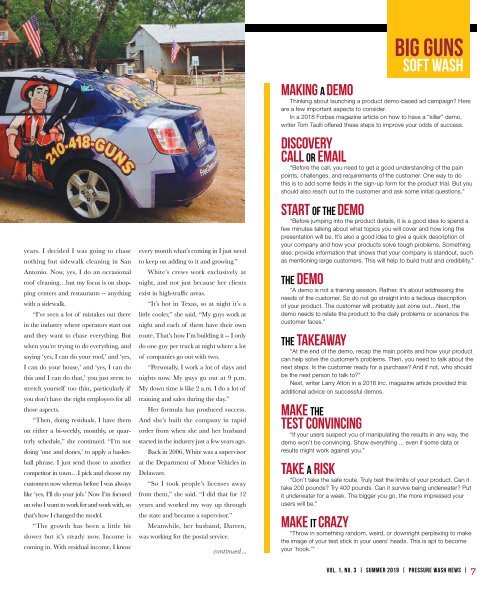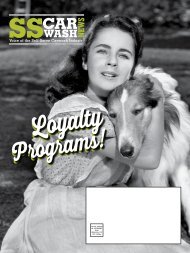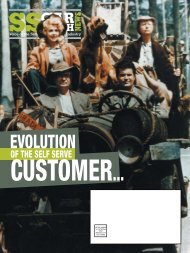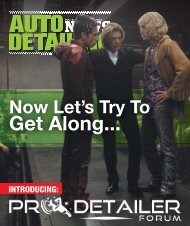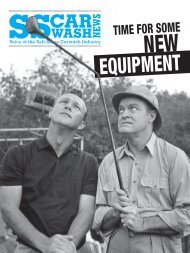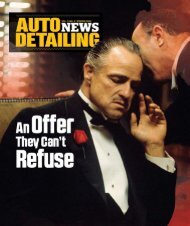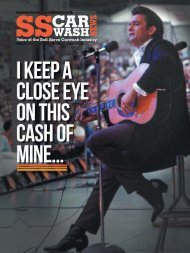Summer 2019
You also want an ePaper? Increase the reach of your titles
YUMPU automatically turns print PDFs into web optimized ePapers that Google loves.
years. I decided I was going to chase<br />
nothing but sidewalk cleaning in San<br />
Antonio. Now, yes, I do an occasional<br />
roof cleaning…but my focus is on shopping<br />
centers and restaurants -- anything<br />
with a sidewalk.<br />
“I’ve seen a lot of mistakes out there<br />
in the industry where operators start out<br />
and they want to chase everything. But<br />
when you’re trying to do everything, and<br />
saying ‘yes, I can do your roof,’ and ‘yes,<br />
I can do your house,’ and ‘yes, I can do<br />
this and I can do that,’ you just seem to<br />
stretch yourself too thin, particularly if<br />
you don’t have the right employees for all<br />
those aspects.<br />
“Then, doing residuals, I have them<br />
on either a bi-weekly, monthly, or quarterly<br />
schedule,” she continued. “I’m not<br />
doing ‘one and dones,’ to apply a basketball<br />
phrase. I just send those to another<br />
competitor in town…I pick and choose my<br />
customers now whereas before I was always<br />
like ‘yes, I’ll do your job.’ Now I’m focused<br />
on who I want to work for and work with, so<br />
that’s how I changed the model.<br />
“The growth has been a little bit<br />
slower but it’s steady now. Income is<br />
coming in. With residual income, I know<br />
every month what’s coming in I just need<br />
to keep on adding to it and growing.”<br />
White’s crews work exclusively at<br />
night, and not just because her clients<br />
exist in high-traffic areas.<br />
“It’s hot in Texas, so at night it’s a<br />
little cooler,” she said. “My guys work at<br />
night and each of them have their own<br />
route. That’s how I’m building it -- I only<br />
do one guy per truck at night where a lot<br />
of companies go out with two.<br />
“Personally, I work a lot of days and<br />
nights now. My guys go out at 9 p.m.<br />
My down time is like 2 a.m. I do a lot of<br />
training and sales during the day.”<br />
Her formula has produced success.<br />
And she’s built the company in rapid<br />
order from when she and her husband<br />
started in the industry just a few years ago.<br />
Back in 2006, White was a supervisor<br />
at the Department of Motor Vehicles in<br />
Delaware.<br />
“So I took people’s licenses away<br />
from them,” she said. “I did that for 12<br />
years and worked my way up through<br />
the state and became a supervisor.”<br />
Meanwhile, her husband, Darren,<br />
was working for the postal service.<br />
continued ...<br />
BIG GUNS<br />
soft wash<br />
MAKING A DEMO<br />
Thinking about launching a product demo-based ad campaign? Here<br />
are a few important aspects to consider.<br />
In a 2018 Forbes magazine article on how to have a “killer” demo,<br />
writer Tom Taulli offered these steps to improve your odds of success.<br />
DISCOVERY<br />
CALL OR EMAIL<br />
“Before the call, you need to get a good understanding of the pain<br />
points, challenges, and requirements of the customer. One way to do<br />
this is to add some fields in the sign-up form for the product trial. But you<br />
should also reach out to the customer and ask some initial questions.”<br />
START OF THE DEMO<br />
“Before jumping into the product details, it is a good idea to spend a<br />
few minutes talking about what topics you will cover and how long the<br />
presentation will be. It’s also a good idea to give a quick description of<br />
your company and how your products solve tough problems. Something<br />
else: provide information that shows that your company is standout, such<br />
as mentioning large customers. This will help to build trust and credibility.”<br />
THE DEMO<br />
“A demo is not a training session. Rather, it’s about addressing the<br />
needs of the customer. So do not go straight into a tedious description<br />
of your product. The customer will probably just zone out…Next, the<br />
demo needs to relate the product to the daily problems or scenarios the<br />
customer faces.”<br />
THE TAKEAWAY<br />
“At the end of the demo, recap the main points and how your product<br />
can help solve the customer’s problems. Then, you need to talk about the<br />
next steps. Is the customer ready for a purchase? And if not, who should<br />
be the next person to talk to?”<br />
Next, writer Larry Alton in a 2016 Inc. magazine article provided this<br />
additional advice on successful demos.<br />
MAKE THE<br />
TEST CONVINCING<br />
“If your users suspect you of manipulating the results in any way, the<br />
demo won’t be convincing. Show everything ... even if some data or<br />
results might work against you.”<br />
TAKE A RISK<br />
“Don’t take the safe route. Truly test the limits of your product. Can it<br />
take 200 pounds? Try 400 pounds. Can it survive being underwater? Put<br />
it underwater for a week. The bigger you go, the more impressed your<br />
users will be.”<br />
MAKE IT CRAZY<br />
“Throw in something random, weird, or downright perplexing to make<br />
the image of your test stick in your users’ heads. This is apt to become<br />
your ‘hook.’”<br />
VOL. 1, NO. 3 | SUMMER <strong>2019</strong> | PRESSURE WASH NEWS | 7


